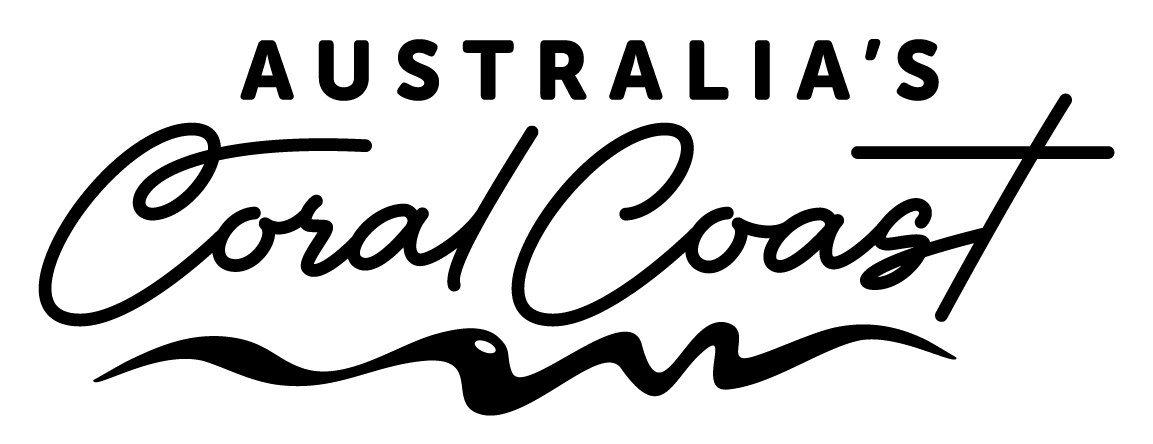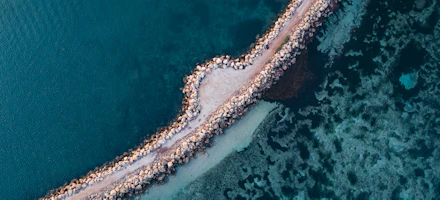
Swim with Humpback Whales
Ningaloo Marine Park, off the coast of Exmouth and Coral Bay, is the only place in Western Australia where you can experience an in-water interaction with migrating humpback whales.
In-water interaction tours take place between July and October each year, as 40,000 humpback whales embark on their annual migration along Western Australia's coastline. You can also enjoy whale watching tours from these towns, as well as from many other destinations in Australia's Coral Coast.
You can see these gentle giants of the ocean on their journey between their breeding grounds in the North West shelf and feeding grounds in the Antarctic. Humpback whales are massive - they can grow up to 19 metres in length and weigh up to 40 tonnes.
All humpback whale swim (in-water interaction) tours focus on small group encounters for intimate and exhilarating experiences that will stay with you for many years to come! In-water interactions are completely on the whale's terms, so if the humpack's behaviour and the weather allow, there will be the chance for a genuine wildlife encounter in the water with them.
Frequently Asked Questions
When do tours operate?
Tours typically operate from 1st July through to October in Coral Bay, and from 1st August through to October in Exmouth. However, as humpback whales are wild animals, these season dates vary year to year based on the whales' migration. If you're visiting Coral Bay or Exmouth early in the humpback whale season, you may also have the opportunity to encounter whale sharks. Ningaloo's whale shark season typically runs until early August, and manta rays can also be encountered year-round from Coral Bay.
Where do tours operate?
Tours operate from both Coral Bay and Exmouth, in Western Australia's Ningaloo Coast World Heritage Area. Humpback whale tours are conducted throughout the entire Ningaloo Marine Park waters, which includes the reef between Coral Bay Exmouth, the North West Cape, Lighthouse Bay, the Muiron Islands, and Bundegi Beach within the Exmouth Gulf.
Qantas flies between Perth and Learmonth (Exmouth) Airport daily. The flight takes just under 2 hours, and from the airport is a 25 minute drive north to Exmouth or a 1 hour, 10 minute drive south to Coral Bay. Between 30 April and 26 October 2023, Qantas also flies direct between Melbourne's Tullarmarine Airport and Learmonth Airport on Sundays and Thursdays.
Alternatively, you can road trip from Perth to Coral Bay and Exmouth along the Coral Coast Highway. This can be experienced as a one-way Fly + Drive Holiday, or as a round-trip, self-drive holiday. Coral Bay is approximately 12 hours' drive north of Perth, and Exmouth is approximately 13 hours (plus stops).
How do swimming with humpback whale tours work?
Humpback whale tours are full day experiences - expect to leave your accommodation around 7:00am and arrive back in the afternoon around 4:00pm or 5:00pm
The humpback whale tour operator's bus will collect you from the designated meeting point or your hotel, to take you to the boat ramp and you'll set out onto the Ningaloo Reef
You'll be given a safety briefing on the boat before having the opportunity to snorkel on Ningaloo's inner reef, while spotter planes locate the humpback whales. Most humpback whale tours include two snorkels on the inner reef, where you can see incredible coral and fish. You'll also have the chance to see, and potentially swim with, manta rays, dolphins and turtles.
You'll continue to Ningaloo's outer reef, following the direction of the spotter plane, and once you near the humpback whales, the vessel will be guided to near the whales so you can observe the gentle giants as they cruise the reef.
7 swimmers will enter the water, accompanied by a divemaster as their guide, who ensure you swim a safe distance from the whales. Your guide has an in-water radio to communicate with the boat, to be kept up to date with the exact location and movement of the humpback whales. This ensures you maintain a safe distance from the whales, whilst guiding you to the best location to intercept the whales.
Your guide will let you know when you put your head beneath the water and watch as these graceful creatures swim near or past you!
The boat will pick up the members of your swimming group, then repeat the process for the next group of 7. The 'jump' is repeated several times before a late lunch is served.
Once you arrive back to shore, the bus will transfer you back to town or your accommodation.
How do swimming with humpback whale tours work?
Throughout Western Australia, licensed whale watching operators can approach humpback whales up to 50 metres. This distance is maintained to ensure there is minimal disturbance to the whales. This is the same with in-water interactions; vessels must stop at least 50 metres from a whale and from there, you will be able to enter the water. Humpback whales are naturally quite curious and often they willl approach a vessel or swimmers closer than this distance.
Can you hear the whales underwater?
Yes! If you have your head underwater while a humpback whale is 'singing' nearby, you'll be able to hear it! Most operators also have a hydrophone (underwater microphone) on board, so you can also hear the whales singing from on board the boat.
Why swim with humpback whales at Ningaloo Reef?
1. Our eco-tourism practices: the Ningaloo humpback whale interaction guidelines have been modelled on the world's best practice whale shark swim tours, which have been proven by leading scientists to be the most eco-friendly and least impactive tours worldwide. Procedures and guidelines are managed and enforced by the Department of Biodiversity, Conservation & Attractions to ensure that tours have minimal impact on the humpback whales, including managing how close vessels and swimmers can get to the whales, how many swimmers can be in the water at any one time, and ensuring that swimmers don't interfere with the whales' natural behaviour. Before a group of swimmers enter the water, the operator will observe and assess the 'mood' and behaviour of the humpback whale(s). Humpback whales are renowned for their playful behaviour, such as tail-slapping and breaching. Swimmers will only be allowed to enter the water with a whale that is calm and relaxed, and not showing any signs of playful behaviour. Similarly, no swimmers are allowed near mothers and calves (a whale deemed 1/2 the size of an accompanying adult), for both the protection and safety of the whales and swimmers.
2. Our high success rate: Ningaloo currently has a 78% in-water interaction success rate. The success rate of humpback whale watching at Ningaloo is higher than this, however the focus on eco and sustainable practices, as outlined above, means that it is not always possible or suitable for an in-water interaction.
3. We capture the moment for you: All Ningaloo humpback whale in-water interaction tour operators have an underwater photographer or videographer on board who can provide lasting memories of the day's swim. All you have to do is take in the incredible experience, knowing someone else is going to make you look good next to these gentle giants!
4. Learn from the best: Each Ningaloo humpback whale in-water interaction includes on board education from dive instructors, most of whom are marine biologists/scientists. Additionally, many tour operators employ staff who are bilingual, so there is a change they'll speak your language (or, at the very least, 'speak to the humpback whales', and make sure you have a great time)
What if I want to go whale watching but not participate in the in-water interaction?
No problem! All operators offer an 'observer' price. Observers can still participate in the inner reef snorkels, but do not participate in the humpback whale in-water interaction. Sometimes manta rays are found and tours have the opportunity to also swim with them. When this happens, observers also have the opportunity to swim with the manta rays. You also have the option to join a dedicated whale watching tour (find out more below)
Which tour do I book?
Check out the list of Coral Bay and Exmouth humpback whale swim tour operators:
Whale watching in the region
In addition to being the only place in Western Australia where you can experience an in-water interaction with humpback whales, the Coral Coast is also home to incredible whale watching opportunities between June and November each year. During these months, the humpback whales migrate from their winter feeding grounds in Western Australia's south to their breeding grounds in Western Australia's north, before returning to the cooler southern waters. Migrating whales spotted between June and August are typically on their northern journey, while whales spotted from August to November are typically on their southern journey.
The Ningaloo Marine Park plays host to a range of whale species in addition to the humbpack whales, and you may be lucky enough to sight orcas, false killer whales, minke whales, bryde whales and blue whales. During spring, the waters of the Exmouth Gulf are an ideal location to see humpback whales playing and nursing their newborn calves.
Humpback whales can also be seen in the Shark Bay World Heritage Area on marine life and sunset cruises, on dedicated whale watching tours from Kalbarri, and on scenic flights and live-aboard cruises from Geraldton.
If you prefer to keep your feet on dry land, there are a number of vantage points throughout the region that offer great opportunities to see migrating humpback whales. These include:
- Exmouth's Vlamingh Head Lighthouse, Bundgei Beach, Mandu Mandu Gorge (in Cape Range National Park).
- Carnarvon's Quobba Station, Red Bluff, Blowholes lookout area and Point Quobba Aquarium.
- Shark Bay's Skipjack Point (in Francois Peron National Park), Steep Point and Turtle Bay (Dirk Hartog Island).
- Kalbarri's Coastal Cliffs, notably Shellhouse Grandstand, Island Rock, Eagle Gorge, Pot Alley, Mushroom Rock, Rainbow Valley, Red Bluff Lookout and Bundegi Trail.
- Geraldton's Back Beach and Esplanade.










































